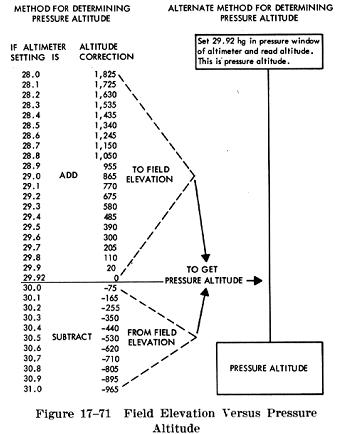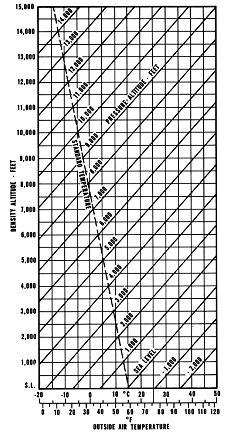| Density Altitude
The more appropriate term for correlating aerodynamic performance in the nonstandard atmosphere is density altitude - the altitude in the standard atmosphere corresponding to a particular value of air density. Density altitude is pressure altitude corrected for nonstandard temperature.
Under standard atmospheric condition, air at each Since density varies directly with pressure, and inversely with temperature, a given pressure altitude may exist for a wide range of temperature by allowing the density to vary. However, a known density occurs for any one temperature and pressure altitude. The density of the air, of course, has a pronounced effect on airplane and engine performance. Regardless of the actual altitude at which the airplane is operating, its performance will be as though it were operating at an altitude equal to the existing density altitude. For example, when set at 29.92" the altimeter may indicate a pressure altitude of 5,000 feet. According to the airplane flight handbook, the ground run on takeoff may require a distance of 790 feet under standard temperature conditions. However, if the temperature is 20 degrees C. above standard, the expansion of air raises the density level. Using temperature correction data from tables or graphs, or by deriving the density altitude with a computer, it may be found that the density level is above 7,000 feet, and the ground run may be closer to 1,000 feet. The computation of density altitude must involve consideration of pressure (pressure altitude) and temperature. Since airplane performance data at any level is based upon air density under standard day conditions, such performance data apply to air density levels that may not be identical with altimeter indications. Under conditions higher or lower than standard, these levels cannot be determined directly from the altimeter. Density altitude can be computed by applying the pressure
altitude and outside air temperature at flight level to a navigation computer.
Density altitude can also be determined by referring to the following table and
chart as shown in Fig. 17-71 and Fig. 17-70.
|


